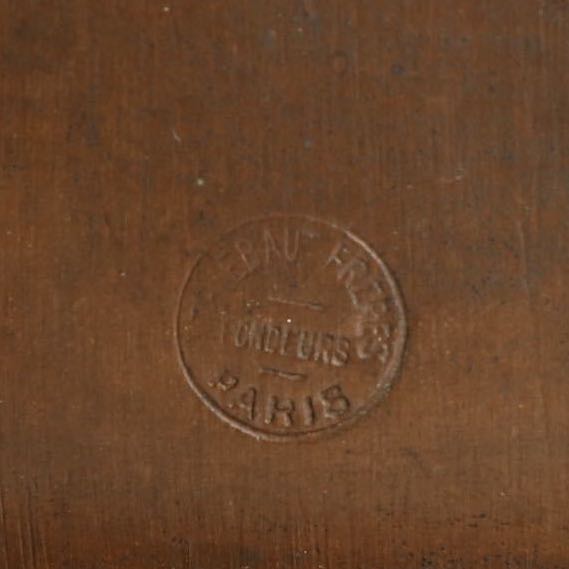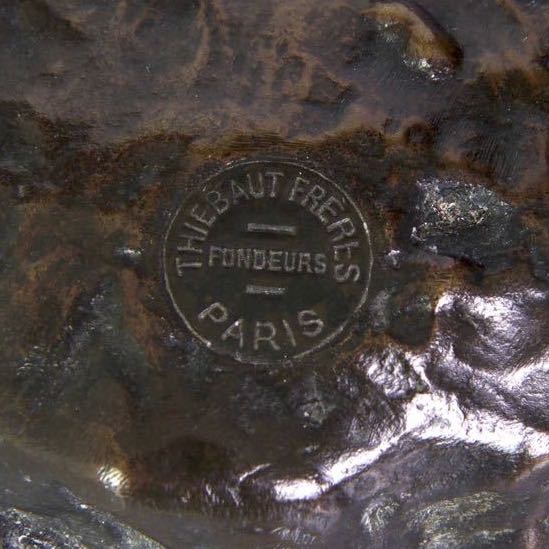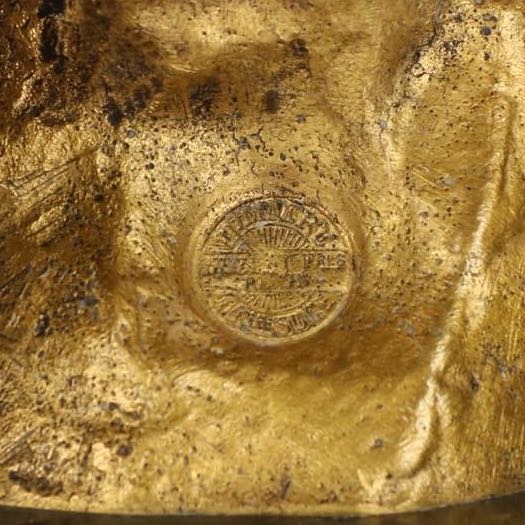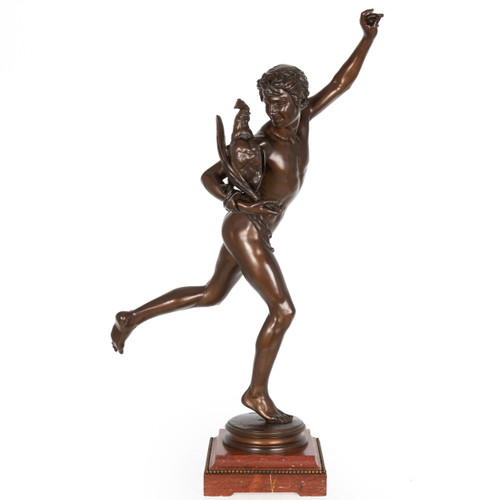Thiebaut Freres
As one of the most important foundries in France, the history of family firm Thiébaut Freres stretches back to the fourth quarter of the 18th century. Born in 1769, Charles Cyprien Thiébaut apprenticed and then became director of a foundry in 1775 that he took over in 1787 as Director. In 1789 he moved the foundry to a new establishment in Paris at 42 Rue du Ponceau where he primarily cast functional objects. His eldest son, Charles Antoine Floréal (1794-1830) joined him and together they operated under the name of Thiébaut et Fils. They designed and manufactured copper cylinders for printing fabric patterns. Charles Cyprien retired in 1823, leaving Charles Antoine at the helm as director of the family foundry.
By 1844, together with his sons Edmond and Victor Theobald (1828-1908), Charles Antoine’s company was becoming well-established as a foundry for important art commissions. Charles Antoine retired and left the company to his two sons, who changed the name of the firm to Thiébaut Freres. Edmond died shortly thereafter in 1848, leaving Victor Theobald the sole owner of the company.
In 1851, Victor Theobald set up a foundry specially suited to handle sub-contracted sand-casting of works for other foundries. These were generally left raw to be finished by the foundries and artists ordering the work from them, including Collas et Barbedienne (who would later start their own foundry in 1857). Thiébaut also cast works for “Editeurs” of bronzes - essentially retailers, who would curate and market works, but did not always produce them. They focused their efforts on mastering every part of the production of art bronzes, which required a more complicated skillset than manufacturing: talented artisans for modeling, ciseleurs for finishing and patineurs for surface work. He partnered with some of the most influential sculptors of the day, obtaining publishing contracts for their work, including the 1850’s purchase of Antoine-Louis Barye’s models of Lion & Lioness from the Debraux foundry, as well as partnerships with David d’Angers, Jean-Alexandre Falguiére, Albert Carrier-Belleuse and Paul Dubois.
In 1875, Victor was joined by his sons Victor-Eugéne, Jules and Henri-Léon. Henri-Léon was a student of sculptor Alexandre Lequien and he produced many independent bronze works in their family foundry. These he exhibited at World Fair in 1878 and the Paris Salon from 1878 through 1898. The catalogue text from the Paris Exposition Universelle of 1889 notes that the Thiébaut Brothers produce “the most difficult and ambitious works of art”; and in the Chicago Universal Exhibition of 1893, their work was noted as being “wonders of casting, chiseling and patina”.
After the death of his two brothers in 1898 and 1899, Victor-Eugéne split off a subsidiary of the company, which he sold to Charles Fumiére and André Gavin, employees of the firm. They added their name to the mark, which reads “Thiébaut Freres, Fumiére et Gavinot Successors” on works produced by them; these had salesrooms at 32, Avenue de l’Opera in Paris. Victor-Eugéne finally ceased all operations in 1901 when he sold the company to Louis Gasne, a Parisian founder. This began a series of sales, where Gasne sold the firm in 1906 to Joseph Malesset, who sold it in 1912 to René Fulda. And in 1919, the firm would be acquired by Charles Fumiére along with the rights to produce works as Thiébaut Freres. In this form, the firm operated from 1920 through 1926 as “Thiébaut Freres, Fumiere et Cie”, after which point they ceased all operations.
As one of the largest foundries in France, their list of accomplishments is significant. Perhaps their most famous work is the circa 1899 reduction of the Statue of Liberty cast by Thiébaut Freres for installation at the end of Swan Island in view of the Eiffel Tower in Paris. The same year saw the casting of the largest monument in Paris, the Triumph of the Republic by Jules Dalou commissioned for the Place de la Nation and almost entirely manufactured by Thiébaut Freres.
Literature & Further Reading:
- The Founders and Editors of the Barye Bronzes, J.G. Reinis, p. 132-133
- Bronzes of the Nineteenth Century, A Dictionary of Sculptors, Pierre Kjellberg
- Dictionary of Art Bronze Founders: France, 1890-1950, Elisabeth Lebon, p. 291
Some examples of their cachet through the years follow below:
 Thiebaut Freres: 1844-1901 |
 Thiébaut Freres, Fumiere et Cie: 1920-1926 |
 Thiebaut Freres: 1844-1901 |
 Thiébaut Freres, Fumiere et Cie: 1920-1926 |


